Oral
Acquisition, Reconstruction & Analysis
Monday, 24 April 2017
| Room 313A |
16:15 - 18:15 |
Moderators: Jacco de Zwart, Emine Saritas |
Slack Channel: #s_acq_recon_analysis
Session Number: O63
16:15
|
0297.
 |
Prediction of Motion Induced Image Degradation Using a Markerless Motion Tracker 
Rasmus Olsen, Helle Johannesen, Otto Henriksen, Lisbeth Marner, Oline Olesen
In this work a markerless motion tracker, TCL2, is used to predict image quality in 3D T1 weighted MPRAGE MRI brain scans. An experienced radiologist scored the image quality for 172 scans as being usable or not usable, i.e. if a repeated scan was required. Based on five motion parameters, a classification algorithm was trained and an accuracy for identifying not usable images of 95.9% was obtained with a sensitivity of 91.7% and specificity of 96.3%. This work shows the feasibility of the markerless motion tracker for predicting image quality with a high accuracy.
|
16:27
|
0298.
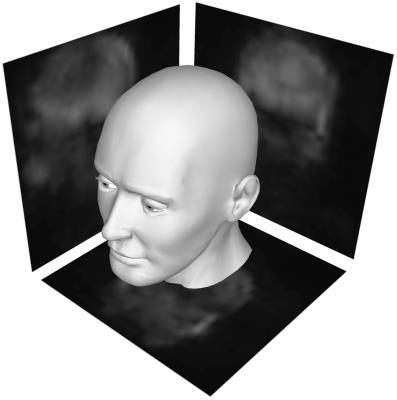 |
Towards a prospective motion correction for the clinic: increasing the accuracy and robustness of collapsed FatNav 
Enrico Avventi, Henric Ryden, Ola Norbeck, Stefan Skare
Collapsed FatNav is a navigator for prospective motion correction which samples the signal from the fat around the skull collapsed along three orthogonal directions with consecutive EPI readouts. The six rigid body motion parameters can be obtained by performing a 2D/3D projection-based registration. In this work we have greatly improved collapsed FatNav's accuracy and precision. Additionally, by combining with PROPELLER's retrospective correction, we can obtain image quality typical of images acquired without motion.
|
16:39
|
0299.
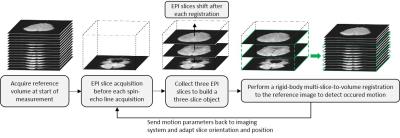 |
A Novel Approach to Prospective Motion Correction Using Multi-Slice-to-Volume Registration 
Daniel Hoinkiss, David Porter
This study introduces a novel 2D-EPI-navigated prospective motion correction technique to correct for in-plane and through-plane motion that establishes a flexible steady-state during the measurement. It utilizes a rigid-body multi-slice-to-volume registration using three parallel and well-separated EPI slices. The technique was evaluated using a well-defined motion protocol with translations up to 13mm and rotations up to 9°, which was executed by a volunteer. Results show a substantial reduction of motion parameters to below ±0.5mm/±0.5° and an increase in overall image quality in comparison to a no-motion scan. The navigator acquisition scheme can be adapted for use with a range of multi-shot 2D sequences to allow EPI navigators to be acquired with limited effect on the overall scan time or the contrast-to-noise ratio.
|
16:51
|
0300.
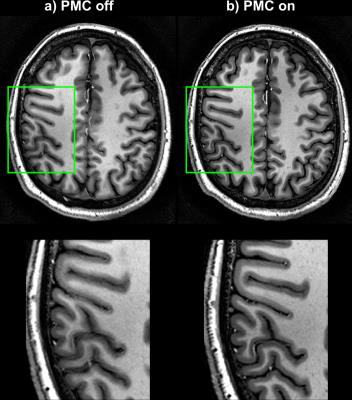 |
Active-marker motion detection with real-time field tracking in the laboratory frame 
Alexander Aranovitch, Maximilian Haeberlin, Simon Gross, Benjamin Dietrich, Lars Kasper, Bertram Wilm, David Brunner, Thomas Schmid, Klaas Pruessmann
We introduce a technique to track NMR markers without a prior calibration measurement. This significantly improves the ease of implementation of field probe based prospective motion correction (PMC). We propose to use rigidly mounted NMR field probes in the laboratory frame to perform concurrent field measurements, which are used for real-time tracking of head-mounted field probes. The proposed method achieves very good tracking performance and is demonstrated in-vivo with PMC of high-resolution brain scans.
|
17:03
|
0301.
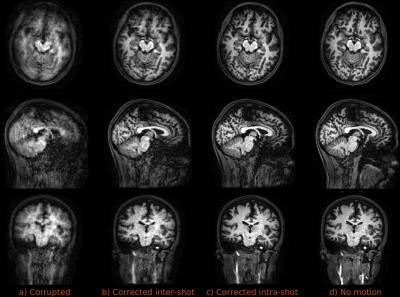 |
Motion correction in volumetric brain imaging based on DISORDER: Distributed and Incoherent Sample Orders for Reconstruction Disentanglement using Encoding Redundancy 
Lucilio Cordero-Grande, Giulio Ferrazzi, Rui Pedro AG Teixeira, Hassan Shahzad, Anthony Price, Joseph Hajnal
The DISORDER framework for motion tolerant reconstruction in parallel volumetric brain imaging synergistically combines distributed and incoherent sample orders with a joint retrospective motion estimation and reconstruction technique based on encoding redundancy provided by coil arrays. DISORDER is fully data-based, does not make use of external sensors or acquisition of navigators, does not require data rejection, and can be applied to different sampling schemes and imaging modalities. In-vivo application of DISORDER has shown robustness against extreme and continuous motion in low resolution images and moderate and continuous motion in standard and high resolution images as well as slightly improved contrast properties in high resolution motion images without deliberate motion.
|
17:15
|
0302.
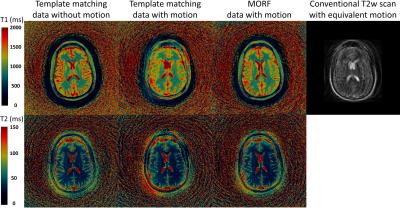 |
Image Reconstruction Algorithm for Motion Insensitive Magnetic Resonance Fingerprinting (MRF) 
Bhairav Mehta, Dan Ma, Simone Coppo, Mark Griswold
Motion is one of the biggest challenges in clinical MRI. The recently introduced Magnetic Resonance Fingerprinting (MRF) has been shown to be less sensitive to motion. However, it is still susceptible to patient motion primarily occurring in the early stages of the acquisition. In this study, we propose a novel reconstruction algorithm for MRF, which decrease the motion sensitivity of MRF. The evaluation of the algorithm was performed using simulated head tilt and nodding motion, and with prospectively motion corrupted data from healthy volunteers.
|
17:27
|
0303.
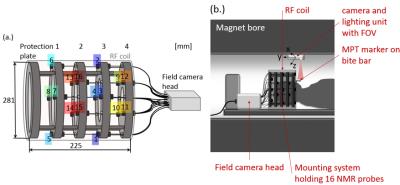 |
Relating external magnetic field changes to head movement using motion and field cameras 
Laura Bischoff, James Smith, Olivier Mougin, Glyn Spencer, Kingkarn Aphiwatthanasumet, Penny Gowland, Richard Bowtell
The effect of head movement in high-field MRI is assessed by measuring changes in the spatial pattern of magnetic field perturbation, generated outside the head, using a set of 16 NMR probes fixed into a specially constructed coil mount. Information from the field probes was combined with head position measurements provided by an optical tracking system and quantitative relations between field and position changes were characterised. By relating the field probe and optical tracking measurements, acquired in a training-phase, it was possible to predict head movements based solely on measured magnetic field changes made in subsequent recordings.
|
17:39
|
0304.
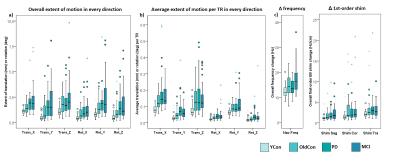 |
On the impact of real-time motion and B0 correction during 3D-MRSI measurements in Parkinson’s, Mild Cognitive Impairment and young/elderly controls 
Eva Heckova, Michal Považan, Bernhard Strasser, Petra Hnilicova, Ovidiu Andronesi, Andre van der Kouwe, Jozef Ukropec, Siegfried Trattnig, Wolfgang Bogner
Presence of motion during MRSI acquisition and scanner instabilities affect the localization accuracy of the measurement and consequential quality of the data. We determined the extent of inter-acquisition head movement, frequency and B0 shim changes during approximately 20 min MEGA-edited MRSI scan with integrated vNav in 4 different groups of subject, with significantly larger amount of head motion in Parkinsons's patients, Mild Cognitive Impairment and elderly controls comparing to young healthy volunteers. With real-time motion, B0 correction and reacquisition we obtained satisfactory data quality in all groups of subjects, which makes it a valuable tool for spectral quality accurance.
|
17:51
|
0305.
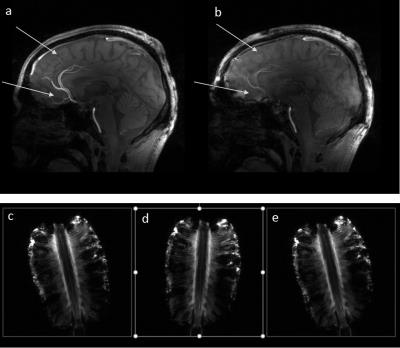 |
AMoCo, a software package for prospective motion correction 
Ali Aghaeifar, Martin Eschelbach, Jonas Bause, Axel Thielscher, Klaus Scheffler
Long scan time makes MRI prone to subject motion which can result in image artifacts. Here we introduce a library for advanced motion correction (AMoCo) for Siemens platforms which can be embedded in any sequence and enables connecting to any tracking device. The library is programmed in a modular way that allows user to customize the correction procedure. The library is integrated with EPI, GRE, and FLASH sequences and tested with various tracking devices.
|
18:03
 |
0306.
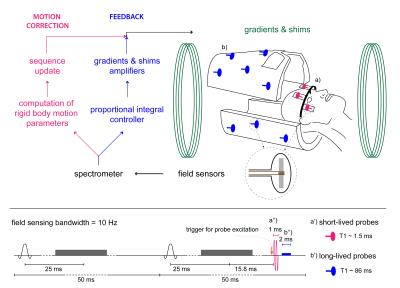 |
Simultaneous prospective motion correction and feedback field control: T2* weighted imaging at high field 
Laetitia Vionnet, Alexander Aranovitch, Yolanda Duerst, Maximilian Haeberlin, Benjamin Dietrich, Simon Gross, Lars Kasper, Thomas Schmid, Klaas Pruessmann
T2* weighted imaging, which is particularly relevant in studying dementia, is prompt to artefacts caused by subject-induced field fluctuation and head motion. Solutions have been proposed to tackle each of these issues separately. In this work we propose to address the two issues concurrently with feedback field control and marker-based prospective motion correction based on gradient-tones. We demonstrate the effectiveness of the combination in the scenario of limb motion.
|
|











